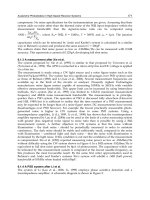Computational Fluid Dynamics 2011 Part 7 pptx
Bạn đang xem bản rút gọn của tài liệu. Xem và tải ngay bản đầy đủ của tài liệu tại đây (805.12 KB, 30 trang )
Computational Fluid Dynamics
174
enhanced through the incorporation of appropriate green features in sustainable
development such that there is a potential saving in non-renewable energy consumption in
buildings.
A commercial CFD package FLUENT has been applied to various research works and found
to be useful [Bojic et al., 2001; Mak et al., 2005b; Mak & Oldham, 1998a; Mak & Oldham,
1998b; Mak & Yik Francis, 2002; Niu et al., 2005]. FLUENT has been adopted by the author
and his research partners [Li & Mak, 2007, ; Li et al., 2006; Mak et al., 2007] to study the
performance of two designed green features including windcathcer and wing walls used for
sustainable buildings. This chapter will introduce the numerical simulation of these two
green features. The CFD numerical technique used including geometry, numerical grids,
boundary conditions and turbulence models will be discussed. The ventilation performance
of these green features in buildings will be discussed. Other CFD applications in building
services engineering such as prediction of flow-generated noise using CFD will also be
briefly introduced.
2. Study of green features for sustainable buildings using CFD
2.1 Windcatcher
2.1.1 Description of the windcatcher
The windcatcher system is one of the green features for providing good natural ventilation.
In the modern design of windcatchers, the principles of wind effect and passive stack effect
are considered in the design of the stack that is divided into two halves or four
quadrants/segments with the division running the full length of the stack [Awbi &
Elmualim, 2002].
The windcatcher systems were employed in buildings in the Middle East for more than
three thousands years. They have different names in different parts of region [Bahadori,
1994; Elmualim et al., 2001; McCarthy, 1999]. Although more and more windcatcher systems
have been applied into recent commercial buildings and residential buildings such as the
Queen’s Buildings at Demonfort University and the BRE office of the future [Hurdle, 2001;
McCarthy, 1999; Swainson, 1997], their performance has not been fully evaluated under
different climates. The experimental studies of windcatcher systems for all different cases
are obviously costly and impossible. The assessment of the performance of windcatcher
systems using CFD is very important for both design and improvement of the systems.
Three-dimensional models of a windcatcher system have therefore been built and their
performance under different wind speeds and flow directions has been studied and
compared [Li & Mak, 2007].
The buildings with only one window opening usually have poor ventilation because it is
difficult for wind to change its direction to enter to the interiors of the buildings, especially
when the window opening is small. The windcatcher is designed for solving this problem
(as shown in Figure 1 (a) and (b)). It can change the direction of wind and channel the fresh
air into rooms (as shown in Figure 2). Generally, the windcatchers are installed on the roof
of a building in order to increase the outdoor-indoor pressure gradient and velocity
gradient, and to provide more fresh air into rooms. In order to induce more air into the
interiors when the wind direction varies, the stack of the windcatcher is usually divided into
two halves or four segments. A numerical modelling of the windcatcher will be discussed in
the following section.
Application of Computational Fluid Dynamics
to the Study of Designed Green Features for Sustainable Buildings
175
(a) (b)
Fig. 1. Comparison of different ventilated rooms
(a) Rooms without windcatcher (b) Rooms with windcatcher
Fig. 2. The structure and principle of the windcatcher system
2.1.2 Numerical simulation of the windcatcher
2.1.2.1 Geometry
It can be seen in Figure 3 that a three dimensional square windcatcher model of dimension
500mm x 500mm and length of 1.0m connected to a room has been created when the wind
speed varies in the range of 0.5-6m/s. The overall numerical domain size is 3.6×3.6×2m (as
shown in Figure 3). In order to show the influence of the wind direction, three additional
models with the incident angle α varying from 0˚ to 45˚ with an interval of 15˚ shown in
Figure 4 (a), (b), (c) and (d) have been created. At the wind direction of 0˚, the performances
of the windcatcher under different wind speeds v of 0.5, 1, 2, 3, 4, 5 and 6m/s were
investigated. Moreover, the flow rate of air entering the room through the windcatcher
under different wind directions and different wind speeds is investigated.
Computational Fluid Dynamics
176
Fig. 3. The 3D model of windcatcher
Fig. 4. Plan of the models under different wind direction
2.1.2.2 Numerical grids, turbulence model and boundary conditions
The accuracy of CFD simulation is affected by numerical schemes, turbulence model, and
boundary conditions used etc. [Marakami, 2002]. It is important to set reasonable boundary
and initial parameters. Since the air flow velocity in and around the windcatcher is much
lower than sound velocity, the flow can be considered as incompressible and the density of air
is assumed to be constant. The wind speed was specified at the inlet and wind friction along
the wall is calculated using the standard wall function. S1 shown in Figure 3 was assumed to
be the natural wind source and was set to be the wind velocity inlet. The turbulence intensity
and the viscosity ratio of this inlet are set to be 3 and 10 respectively. S6 was assumed to be the
Application of Computational Fluid Dynamics
to the Study of Designed Green Features for Sustainable Buildings
177
outlet of wind and was set to be the pressure outlet. S2, S3, S4 and S5 are the connection of the
square windcatcher to the room. In the cases shown as Figure 4 (a), (b) and (c), S2 was set to be
pressure outlet and others pressure inlet while in case shown as Figure (d), S2 and S3 are both
set to be pressure outlet and the other two pressure inlet. The boundary conditions are based
on the experiments of Awbi and Elmualim [Awbi & Elmualim, 2002]. The standard (two-
equation) k-ε turbulence model was adopted. Although this turbulence model inevitably
introduces some errors [Murakami, 1997], it has been chosen because the overall trend of
airflow parameters such as pressure and air velocity can be reasonably predicted [Bojic et al.,
2001; Mak & Oldham, 1998a; Mak & Oldham, 1998b; Murakami, 1997; Niu & Zhu, 2004]. The
total number of grids in all simulation models is all around 50,000 and the maximum and
minimum grid volume is about 2.7×10-4m3 and 3.2×10-7m3 respectively. Unstructured grid
was used for all simulation models (as shown in Figure 5).
Fig. 5. Grid information of the model (cross-section)
2.1.3 Results and analysis
2.1.3.1 Verification of the simulation result
The numerical results are compared with the published experiment results of Awbi and
Elmualim [Awbi & Elmualim, 2002]. Figure 6(a), (b), (c) and (d) show that the airflow rate Q
0.00
0.02
0.04
0.06
0.08
0.10
0.12
0.14
0.16
0.18
0.20
0123456
v (m/s)
Q (m
3
/s)
simulation
ex
p
eriment
(a)
Computational Fluid Dynamics
178
0.00
0.05
0.10
0.15
0.20
0.25
0.30
0123456
v (m/s)
Q (m
3
/s)
simulation
ex
p
eriment
(b)
0.00
0.02
0.04
0.06
0.08
0.10
0.12
0.14
0.16
0.18
0123456
v (m/s)
Q (m
3
/s)
simulation
ex
p
eriment
(c)
0.00
0.05
0.10
0.15
0.20
0.25
0.30
0123456
v (m/s)
Q (m
3
/s)
simulation
ex
p
erimen
t
(d)
Fig. 6. Comparison of simulation and experiment results
(a) α = 0º (b) α =15º (c) α = 30º (d) α = 45º v=external wind speed
Application of Computational Fluid Dynamics
to the Study of Designed Green Features for Sustainable Buildings
179
entering into the test room though S2 at the wind incidence angle of 0º, 15º, 30º and 45º
respectively. It can be seen that the simulation results have a good agreement with the
experimental results and similar trend have been obtained for the other cases. The
percentage of error between the simulation results and the experiments is in the range of -
5% and 30%.
2.1.3.2 Function of the windcatcher quadrants
The windcatcher has been divided into four quadrants in order to induce wind from all
directions and one or two quadrants will be the air inlet of the test room while others being
the outlet. To figure out the specific function of each quadrant is essential for the calculation
of indoor air flow rate and the control of windcatcher system. Since it is impossible to
conduct experiment to obtain velocity and pressure at every point by velocity or pressure
sensors on each quadrant. CFD tool is adopted here.
The velocity distribution on the cross-section of four quadrants at the wind incidence angle
of 0º, 15º, 30º and 45º is shown in Figure 7. It demonstrates that when the incidence angle α =
0º and 15º, only the windward side S2 acts as the air supply quadrant of the test room, but
when α = 30º and 45º, both S2 and S5 take the responsibility of inducing wind into room as
well as exhausting the indoor air out. A few of short circling flow has been observed and its
influence will be studied in future work. The flow of S5 is therefore taken into consideration
when calculating the indoor flow rate of 30º and 45º.
(a)
Computational Fluid Dynamics
180
(b)
(c)
Application of Computational Fluid Dynamics
to the Study of Designed Green Features for Sustainable Buildings
181
(d)
Fig. 7. Velocity distribution on the cross-section of four quadrants
(a) α = 0º (b) α =15º (c) α = 30º (d) α = 45º
2.1.3.3 Performance of the windcatcher under different wind speed
The calculated air flow rate of supply air inlet under different wind incidence angle α of 0º,
15º, 30º and 45º was found to increase with the external wind speed (as shown in Figure 8).
At an angle of 0˚ the ventilation rates are generally lower than for the other three cases and
at the angle of 45˚ the ventilation rate increases more quickly than other cases with the
external wind speed. At α = 0º, a volumetric airflow of 0.093m3/s was achieved through the
main supply quadrant for an average wind velocity of 3m/s and a maximum value of
0.00
0.05
0.10
0.15
0.20
0.25
0.30
0123456
v (m/s)
Q (m
3
/s)
a=0° a=15°
a=30° a=45°
Fig. 8. The variation of ventilation rate with v external wind speed
Computational Fluid Dynamics
182
Fig. 9. Positions of x1
0.00
1.00
2.00
3.00
4.00
5.00
6.00
7.00
0.05 0.1 0.15 0.2 0.25 0.3
x1(m)
vs (m/s)
v=1m/s v=3m/s
v=4m/s v=6m/s
(a)
0.00
1.00
2.00
3.00
4.00
5.00
6.00
0.15 0.2 0.25 0.3 0.35 0.4 0.45
z1(m)
vs (m/s)
v=1m/s v=3m/s v=4m/s v=6m/s
(b)
Fig. 10. The variation of air velocity when α=0˚
(a) along with x1 (b) along with z1
vs=velocity of air supply into room, v=external wind speed
0.185m3/s for the external wind speed of 6m/s. At α = 45º, the maximum volumetric
airflow rate reaches 0.282m3/s when there are two air supply quadrants. Since the volume
Application of Computational Fluid Dynamics
to the Study of Designed Green Features for Sustainable Buildings
183
of the test room is 15.25m3, the maximum indoor air exchange rate (ACH) is about 70 and
thus can keep indoor air at a healthy level in most cases.
Figure 10 (a) and (b) show the variation of wind speed along with x1 and z1 respectively
when the wind incidence angle is 0˚. x1 and z1 are both in the center of the supply air inlet
(as show in Figure 9). It can be seen from the figures that when the wind incidence angle is
0˚, the maximum wind speed induced into text room is close to the external wind velocity. It
demonstrates that it is an effective way to induce natural fresh air into room by using a
windcatcher system.
2.1.3.4 Performance of the windcatcher under different wind direction
It seems that the volumetric airflow rate increases with the external wind incidence angle
(shown as Figure 8), but different result has been obtained by investigating three additional
models under the wind incidence angle of 10º, 25º and 40º. The variation of ventilation rate
with the wind direction when the external wind velocity v=3m/s is shown in Figure 11 and
it demonstrates that airflow rate increases with the incidence angle only in the range of
10º~40º and when α is smaller than 10º or larger than 40º, the trend becomes opposite.
Similar results have been observed in other cases. The installation angle of windcatcher
should therefore be adjusted in order to operate better in different regions.
0.07
0.08
0.09
0.10
0.11
0.12
0.13
0.14
0.15
0 5 10 15 20 25 30 35 40 45
α (º)
Q (m
3
/s)
Fig. 11. The variation of ventilation rate with the wind direction
2.1.3.5 Uniformity of supply air inlet
The variance of airflow velocity into text room is used here to compare the uniformity of
supply air inlet. It is defined as:
})]({[)(
2
vsEvsEvsD −=
(1)
where E(vs) is the mathematical expectation of the supply air velocity vs and the value of vs
is obtained from random points at the line x1 and z1, see Figure 9. When D(vs) increases, the
uniformity of supply air becomes worse.
The results at wind velocities from 0.5 to 6m/s and wind angle of 0º and the results at wind
angles from 0º to 45º and wind angle of 3m/s are shown in Figure 12(a) and (b) respectively.
From these figures, it can be seen that the uniformity of supply air inlet decreases with the
Computational Fluid Dynamics
184
external wind velocity and increases with incidence angle. Therefore, in the application of
the windcatcher system, diffusers should be installed at the inlet entering the text room in
order to keep the occupants comfortable.
0.0
1.0
2.0
3.0
4.0
5.0
6.0
7.0
8.0
9.0
10.0
0123456
v (m/s)
D(vs)
(a)
0.515
0.520
0.525
0.530
0.535
0.540
0.545
0.550
0.555
0.560
0.565
0153045
a(º)
D(vs)
(b)
Fig. 12. The variance of air flow velocity of the air entering into the text room against
external wind speeds and wind directions
2.2 Wing walls
2.2.1 Description of the wing walls
There is a growing consciousness of the environmental performance of buildings. The use of
green features in building design not only improves the environmental quality, but also
reduces the consumption of non-renewable energy used in active control of indoor
environment. Larger window openings in the walls of a building may provide better natural
ventilation. However, it also increases the penetration of direct solar radiation into indoor
environment. The use of wing wall as shown in Figure 13 is an alternative to create effective
natural ventilation. Figure 13 shows the provision of wing wall in a building façade
vertically between two openings. Natural ventilation is considered to be an effective passive
cooling strategy in building design. In 1962 and 1968, Givoni [Givoni, 1962; Givoni, 1968]
conducted experiments on room models with and without wing walls in a wind tunnel so as
to study its effect on natural ventilation. He found that single-sided ventilation incorporated
Application of Computational Fluid Dynamics
to the Study of Designed Green Features for Sustainable Buildings
185
with wing walls could greatly improve the internal air circulation compared with that
without wing walls. Maximizing the utilization of natural ventilation therefore not only
minimize the reliance on active means for environmental control, but also reduces the
consumption of non-renewable energy.
Fig. 13. Physical configuration of wing walls
2.2.2 Experiments of Givoni
The experiments of Givoni [Givoni, 1962; Givoni, 1968] were conducted to study air flow
through room models with and without wing walls in a wind tunnel. Figure 14 and Figure
15 show the plan and side elevation of the open-throat type wind tunnel respectively. It
consists of an intake section, a working section, a distribution control section, a transit
section, a fan and an exit.
It can be seen in Figure 14 and Figure 15 that the intake opening has a cross section of 1.8 x
1.1m(H) and contracts to a cross section of 1.5 x 0.8m(H), over a length of 0.9m. The working
section is 2.22x1.2m(H). The distribution control section contracts in cross section from
1.5x0.8m(H) to 0.8x0.6m(H) and contains five vertical louvers whose angle can be adjusted
so as to regulate flow distribution. The transit sections are used for connecting the
rectangular and circular section.
The room model of dimension of 0.65x0.65x0.5m(H) with a centered window opening
shown in Figure 14 and Figure 15 with dashed lines was located at the center of the wind
tunnel. The window opening with dimension of 1/3 of that of the wall was created at the
center of the wall of the room model facing the air flow.
Fig. 14. Plan elevation of the wind tunnel experiments
Computational Fluid Dynamics
186
Fig. 15. Side elevation of the wind tunnel experiments
The wind tunnel was then tested with different uniform air (wind) flow velocities ranging
from 1.27m/s to 3.35m/s. Different wind directions were tested with the angle of air flow
incidence ranging from 0o (opening facing the air flow) to 135o with 22.5o increment. The
average internal velocity based on five measurement points inside the room model was
expressed in percentage based the inlet uniform air flow velocity (wind speed).
2.2.3 Numerical simulation of the wing walls
2.2.3.1 Geometry
There are three major parts in the FLUENT CFD code. They are: i) pre-processor, ii) solver
and iii) post-processor. The pre-processor GAMBIT was applied to create 3-dimensional
physical room models that are based on the experiments of Givoni. Figure 16 shows the
geometry of the 3-dimensional computational domain where the room model of 0.65m x
0.65m x height 0.5m is located inside the computational domain. There are two lateral
openings in the room model (Case 1). The wind angle is 0° when the lateral openings on the
wall are facing the wind and their normal is in parallel to the wind as shown in Figure 16.
Fig. 16. Physical model for computer simulation
Application of Computational Fluid Dynamics
to the Study of Designed Green Features for Sustainable Buildings
187
2.2.3.2 Numerical grids, discretization scheme, turbulence model and boundary conditions
The FLUENT CFD package is used here in modeling the natural ventilation by solving the
conservation equations for mass, momentum and energy using the finite volume method. A
simple standard (two-equation) k-ε turbulence model was used though it was inevitable to
introduce some errors [Murakami, 1997]. The number of uniform structured grids for the 3-
dimensional simulation is around 60000 – 68000 while the number of grids for the 2-
dimensional simulation is around 12700. The first-order upwind discretization scheme was
used. All CFD results have been checked against energy conservation. Figure 17 shows the
grids of the simulated model. Figure 18 shows the model configurations for all cases at
different wind angles. Table 1 and Figure 18 show the different inlet uniform wind speeds
and wind angles for all cases respectively.
Fig. 17. Grids of the simulation model
Fig. 18. Different wind angles
Different inlet mean wind
speeds (m/s)
1.27
1.68
1.83
2.0
2.95
3.35
Table 1. Different inlet mean wind speeds
Computational Fluid Dynamics
188
The descriptions of all three cases for the 2-dimensional and 3-dimesional CFD simulation
and the wind tunnel experiments of Givoni are shown in Figure 19 and as follows:
Case 1: Two lateral openings, with total 1/3 width of wall, no vertical projections (wing wall)
Case 2: Two lateral openings, with total 1/3 width of wall and vertical projections (wing
wall) of depth equal to the opening width
Case 3: Two lateral openings, with total 1/3 width of wall and vertical projections (wing
wall) of depth double the opening width
Fig. 19. Model configuration at different wind directions
Figure 20 shows the physical configuration of the room model for the three cases.
(a) Case 1: Two lateral openings, with 1/3width of wall, no vertical projections
Different wind angles (0°, 22.5°, 45°, 67.5° and 135° for all three cases)
Application of Computational Fluid Dynamics
to the Study of Designed Green Features for Sustainable Buildings
189
(b) Case 2: Two lateral openings, with 1/3 width of wall and vertical projections (wing
walls) of depth equal to the opening width
(c) Case 3: Two lateral openings, with 1/3 width of wall and vertical projections (wing
walls) of depth double the opening width
Fig. 20. Physical configuration of the room model for three cases
2.2.4 Analysis of results
2.2.4.1 Effect of input turbulence on the CFD results
It is known the approaching turbulence levels would impact the curvature of separation on
a bluff body and as a result affect the mean pressure data derived [Melbourne, 1979].
However, there is no information provided regarding the input turbulence levels used in the
Computational Fluid Dynamics
190
experiments of Givoni [Givoni, 1962; Givoni, 1968]. As the wind tunnel experiments of
Givoni were conducted at low-turbulence, different low input turbulence parameters
including turbulence intensity and turbulence viscosity ratio were used in the three-
dimensional simulation models shown in Table 2. It was found in Figure 21 that the
variation in the incoming turbulence did not have much effect on CFD result, i.e. the mean
indoor air speed relative to the uniform wind speed. In the CFD results, the mean indoor air
speed could be based on all grid point values inside the room at a particular uniform wind
speed while that in the experiments of Givoni [Givoni, 1962; Givoni, 1968] was only based
on five selected measurement points inside the room.
Set
Turbulence
Intensity/%
Turbulence
Viscosity ratio
A 10 10
B 10 1
C 1 1
D 1 0.1
E 1 0.01
F 1 0.001
G 0.1 0.001
Table 2. Different input turbulence parameters
0
2
4
6
8
10
12
14
16
18
0 20 40 60 80 100 120 140 160
Wind angle (
o
)
% of indoor air speed to wind speed
Givoni
A
B
C
D
E
F
Fig. 21. Effect of different turbulence input parameters on CFD results
2.2.4.2 Effect of wing wall
It can be seen in Figure 22 and Figure 23 that the wing wall increases the air circulation in
and out of the two lateral openings of the room model. Figure 24 and Figure 25 show that
the wing wall increases the pressure difference between the two lateral openings. Figures
26-29 show the CFD results for the models and the experimental results of Givoni. Givoni
Application of Computational Fluid Dynamics
to the Study of Designed Green Features for Sustainable Buildings
191
[Givoni, 1962; Givoni, 1968] found that the percentage of mean indoor air speed to uniform
wind speed remained almost constant as the uniform wind speed varied from 1.27ms-1 to
3.35 ms-1. This percentage and the air change per hour in the CFD results were obtained by
taking average all values at different wind speeds listed in Table 1. It can be seen in Figure
26 that the percentage of mean indoor air speed inside the room to the uniform wind speed
is increased by the incorporation of wing wall on the wall facing the wind. Significant
improvement of natural ventilation is obtained in the cases with wing wall (i.e. case 2 and 3)
in both experimental results and CFD results. The increase in the mean indoor velocity in
two cases with wing wall can be reached up to few times compared with those without
wing wall. However, it can be seen in Figure 26 that there is no significant improvement of
natural ventilation for a longer wing wall (Case 3) is used.
Fig. 22. Plan view of velocity vector diagram for the room model without wing wall at wind
angle of 45
o
and wind speed of 1.25m/s
Fig. 23. Plan view of velocity vector diagram for the room model with wing wall at wind
angle of 45
o
and wind speed of 1.25m/s
Computational Fluid Dynamics
192
Fig. 24. Plan view of pressure contour of the room model without wing wall at wind angle
of 45
o
and wind speed of 1.25m/s
Fig. 25. Plan view of pressure contour of the room model with wing wall at wind angle of
45
o
and wind speed of 1.25m/s
Application of Computational Fluid Dynamics
to the Study of Designed Green Features for Sustainable Buildings
193
0
5
10
15
20
25
0 20 40 60 80 100 120 140 160
Wind angle (
o
)
% of indoor air speed to wind speed
Case 1
Case 2
Case 3
Fig. 26. Percentage of mean indoor air speed to wind speed against wind angle ranging 0°
and 135° (CFD results for three cases)
0
50
100
150
200
250
300
350
400
450
500
0 20 40 60 80 100 120 140 160
Wind angle (
o
)
Air change per hour
Cas e 1
Cas e 2
Cas e 3
Fig. 27. Ventilation rate (in m
3
/s) against wind angle ranging 0° and 135° (CFD results for
three cases)
2.2.4.3 Performance of wing wall under different wind directions
In order to compare the CFD results with the experiments of Givoni, the percentage of mean
indoor air speed to uniform wind speed was used in Figures 26, 28-30. Air change per hour
was also used in Figure 27 since it is a common indicator of ventilation. It can be seen in
Figure 26 and Figure 27 that there are large variations of the percentage of mean indoor air
speed to wind speed and the air change per hour in case 2 and case 3 under different wind
directions (i.e. wing angle ranging 0° and 135°). Highest values of the percentage of mean
indoor air speed to wind speed and the ventilation rate occur at around 45°. That means
although wing wall can increase the air change per hour and the mean indoor air velocity
that would promote natural ventilation, its performance is greatly affected by the wind
directions. Figures 26-30 all show that the wing wall has its best performance at wind angle
of around 45
o
.
Computational Fluid Dynamics
194
2.2.4.4 Comparison of CFD results and the experiments of Givoni
Figures 28-30 show the comparisons between CFD results and wind tunnel experiments of
Givoni [Givoni, 1962; Givoni, 1968] for cases 1-3. There is no wing wall in Case 1. Case 3 has
a longer wing wall than Case 2. It can be seen in the figures that the CFD results generally
have similar trend to the experimental results of Givoni. The deviations may be due to the
limitations of the CFD code in terms of algorithm used for the computer iterations, grid
topologies, physical parameters used and turbulence models, and the measurement
methods used in the experiments. Givoni [Givoni, 1962; Givoni, 1968] found that the
internal velocity distribution inside the room was quite constant at the wind angle of 45°
and wind speed of 1.25m/s to 3.3m/s and the mean indoor air speed was obtained by
averaging speeds measured at only 5 measurement points. However, there are larger
variations of internal velocity distribution in the simulation and the mean indoor air speed
in the CFD results was obtained by averaging speeds at all grid points inside the rooms.
0
2
4
6
8
10
12
14
16
18
0 20 40 60 80 100 120 140 160
Wind angle(
o
)
% of indoor air speed to wind speed
CFD simulation
Givoni
Fig. 28. Percentage of mean indoor air speed to wind speed against wind angle ranging 0°
and 135° (Case 1-comparison between CFD results and the experiments of Givoni)
0
5
10
15
20
25
30
35
40
0 20406080100120140160
Wind angle (
o
)
% of indoor air speed to wind speed
CFD simulation
Givoni
Fig. 29. Percentage of mean indoor air speed to wind speed against wind angle ranging 0°
and 135° (Case 2-comparison between CFD results and the experiments of Givoni)
Application of Computational Fluid Dynamics
to the Study of Designed Green Features for Sustainable Buildings
195
0
5
10
15
20
25
30
35
40
0 20 40 60 80 100 120 140 160
Wind angle (
o
)
% of indoor air speed to wind speed
CFD simulation
Givoni
Fig. 30. Percentage of mean indoor air speed to wind speed against wind angle ranging 0°
and 135° (Case 3-comparison between CFD results and the experiments of Givoni)
3. Other CFD applications in building services engineering (BSE)
CFD has been applied successfully to various research works in BSE [Chow, 1996] including
fire engineering, smoke movement, sprinkler and hot air interaction, combustion, heating,
ventilation and air-conditioning design, air-conditioned gymnasium and air-conditioned
office. CFD has also been attempted to modify the predictive method of Mak et al. [Mak,
2002; Mak, 2005; Mak et al., 2009; Mak & Yang, 2000; Mak & Yang, 2002] to produce a
turbulence-based predictive for flow-generated noise produced by an in-duct element in a
ventilation system [Mak & Au, 2009; Mak & Oldham, 1998a; Mak & Oldham, 1998b].
4. Conclusions
This chapter has reviewed the numerical studies of the performance two green features used
in buildings. For the performance of windcatcher, the air flow rate increases with wind
speed and wind direction when incidence angle varies from 10º to 40º and slightly decreases
when incidence angle is smaller than 10º or lager than 40º. In all cases studied, the velocity
of the supply air entering into the text room is close to the external wind speed and
therefore the windcatcher system is found to be an efficient way of improving indoor
ventilation. For the performance of wing walls, wing wall can promote natural ventilation
by increasing the air change per hour and the mean indoor air speed relative to wind speed
at various wind speeds and wind directions. The best performance is at the wind angle of
around 45°. The numerical studies agree generally with the experiments of Givoni and show
that wing wall can perform very well in single-sided ventilation for this type of room
configurations. In summary, the numerical studies have shown that the windcatcher and
the wing walls can increase the performance of natural ventilation in buildings. CFD is
therefore a useful tool in studying the performance of green features used in buildings.
Computational Fluid Dynamics
196
5. Acknowledgements
The writing of this chapter was fully supported by a grant from the Fcaulty of Constuction
and Land Use of the Hong Kong Polytechnic University (Sustainable Urbanization Research
Fund, Project No. 1-ZV4S).
6. References
Awbi, H.B. (1989). Application of computational fluid dynamics in room ventilation.
Building and Environment, Vol. 24, No. 1, pp. 73-84
Awbi, H.B. & Elmualim, A.A. (2002). Full scale model windcatcher performance evaluation
using a wind tunnel, Proceedings of the World Renewable Energy Congress VII, 2002
Bahadori, M.N. (1994). Viability of wind towers in achieving summer comfort in the hot arid
regions of the Middle-East. Renewable Energy, Vol. 5, pp. 879-892
Bojic, M.; Lee, M. & Yik, F. (2001). Influence of a depth of a recessed space to flow due to air-
conditioner heat rejection. Energy and Buildings, Vol. 34, No.1, pp. 33-43
Chen, Q. (2009). Ventilation performance prediction for buildings: A method overview and
recent applications. Building and Environment, Vol. 44, pp. 848-858
Chen, Q. & Srebric, J. (2000). Application of CFD tools for indoor and outdoor environment
designs. International Journal on Architectural Science, Vol. 1, pp. 14-29
Chow, W.K. (1996). Application of computational fluid dynamics in building services
engineering. Building and Environment, Vol. 31, pp. 425-36
Elmualim, A.A.; Awib, H.B.; Teekaram, A.J. & Brown, R.G. (2001). Evaluating the
Performance of a Windcatcher System Using Wind Tunnel Testing, Proceedings of
22nd Annual AIVC Conference, Vol. 1, pp. 29.1-29.12, Bath, UK, 11-14 September
2001, Air Infilteration and Ventilation Centre, INIVEEIG, Belguim
Givoni, B. (1962). Basic study of Ventilation problems in housing in hot countries. Research
Report to the Ford Foundation, Building Research Station, Israel Institute of
Technology, Technion, Haifa, Israel
Givoni, B. (1968). Ventilation problems in hot countries. Research Report to the Ford
Foundation, Building Research Station, Israel Institute of Technology, Technion,
Haifa, Israel
Hurdle, A. (2001). Is natural ventilation the new wind of change?. Building Services and
Environmental Engineers, Vol. 24, No. 7, pp. 26-7
Jones, P.J. & Whittle, G.E. (1992). Computational fluid dynamics for building air flow
prediction-current status and capabilities. Building and Environment, Vol. 27, No. 3,
pp. 321-38
Li, L. & Mak, C.M. (2007). The assessment of the performance of a windcatcher system using
computational fluid dynamics. Building and environment, Vol. 42, pp. 1135-41
Li, L.; Mak, C.M & You, S.J. (2006). A numerical study of the performance of a windcatcher
system. Proceedings of Sichuan-Hong Kong Joint Symposium, pp. 34-43, Chengdu,
Sichuan, China
Mak, C.M. (2002). Development of a prediction method for flow-generated noise produced
by duct elements in ventilation systems. Applied Acoustics, Vol. 63, pp. 81-93
Application of Computational Fluid Dynamics
to the Study of Designed Green Features for Sustainable Buildings
197
Mak, C.M. (2005). A prediction method for aerodynamic sound produced by multiple
elements in air ducts. Journal of Sound and Vibration, Vol. 287, pp. 395-403
Mak, C.M. & Au W.M. (2009). A turbulence-based prediction technique for flow-generated
noise produced by in-duct elements in a ventilation system. Applied Acoustics, Vol.
70, pp. 11-20
Mak, C.M.; Cheng, C. & Niu, J.L. (2005a). The application of computational fluid dynamics
to the assessment of green features in buildings: Part 1: Wing walls. Architectural
Science Review, Vol. 48, No. 1, pp. 121-34
Mak, C.M.; Cheng, C. & Niu, J.L. (2005b). The application of computational fluid dynamics
to the assessment of green features in buildings: Part 1: Wing walls. Architectural
Science Review, Vol. 48, No. 1, pp. 1-14
Mak, C.M.; Niu, J.L.; Lee, C.T. & Chan, K.F. (2007). A numerical simulation of wing walls
using computational fluid dynamics. Energy and Buildings, Vol. 39, pp. 995-1002
Mak, C.M. & Oldham, D.J. (1998a). The application of computational fluid dynamics to the
prediction of flow-generated noise in low speed flow ducts. Part 1: Fluctuating drag
forces on a flow spoiler. Journal of Building Acoustics, Vol. 5, No. 2, pp. 123-41
Mak, C.M. & Oldham D.J. (1998b). The application of computational fluid dynamics to the
prediction of flow-generated noise in low speed flow ducts. Part 2: Turbulence-
based prediction technique. Journal of Building Acoustics, Vol. 5, No. 3, pp. 199-213
Mak, C.M.; Wu, J.; Ye, C. & Yang, J. (2009). Flow noise from spoilers in ducts. Journal of the
Acoustical Society of America, Vol. 125, No. 6, pp. 3756-65
Mak, C.M. & Yang J. (2000). A prediction method for aerodynamic sound produced by
closely spaced elements in air ducts. Journal of Sound and Vibration, Vol. 229, No. 3,
pp. 743-53
Mak, C.M. & Yang J. (2002). Flow-generated noise radiated by the interaction of two strip
spoilers in low speed flow ducts. Acta Acustica united with Acustica, Vol. 88, pp. 861-
68
Mak, C.M. & Yik Francis, W.H. (2002). A study of natural ventilation in a kitchen using
computational fluid dynamics (CFD). Architectural Science Review, Vol. 45, pp. 1-8
McCarthy, B. (1999). Wind Towers: Details in building, Academy Edition, John Wiley & Sons,
West Sussex, UK
Melbourne, W.H. (1979). Turbulence effects on maximum surface pressures; a mechanism
and possibility of reduction. Proceedings of the Fifth International Conference on Wind
Engineering, pp. 541-51, Fort Collins, USA, July 1979, edited by Cermak, J.E.
Murakami, S. (1997). Current status and future trends in computational wind engineering.
Journal of Wind Engineering and Industrial Aerodynamics, Vol. 67-68, pp. 3-34
Murakami, S. (2002). Setting the scene: CFD and symposium overview. Wind and Structures,
Vol. 5, No. 2-4, pp. 83-8
Niu, J.L. & Kooi, J.V.D. (1992). Two-dimension simulation of the air flow and thermal
comfort in a room with open-window and indoor cooling systems. Energy and
Buildings, Vol. 18, No. 1, pp. 65-75
Niu, J.L.; Yuen, Y.M. & Mak, C.M. (2005). The application of Computational Fluid Dynamics
to the assessment of green features in buildings: Part 2: Communal sky gardens.
Architectural Science Review, Vol. 48, pp. 337-44









